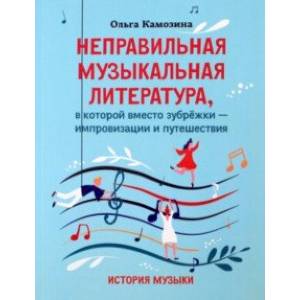Incorrect musical literature, in which improvisation and exploration are emphasized instead of rote learning
Please sign in so that we can notify you about a reply
The book is intended for primary school students in the Children"s School of School and Children"s Affairs, studying the subject of "listening to music". Since the proposed teaching methodology is based on the obtained auditory, performing and elementary composer skills presented in the manual "The wrong solfeggio, in which instead of rules - songs, pictures and different stories, the author allowed himself to name the manual on the subject of" listening to music "" of incorrect musical literature ".
"The wrong solfeggio" and "incorrect musical literature" mutually complement each other in the study of different aspects of musical art - the elementary theory of music and its history. The knowledge and skills gained in solfeggio lessons develop and are fixed in the lessons in listening to music. The presenter is the basic principle of studying music by children, expressed by G. I. Shatkovsky: "Ears are listening, and he thinks his head", which runs children away from scholasticism in theory and tightness in the course of "musical literature". In the lessons of solfeggio and the listening of music, the main forms of training are game, improvisation, joint music. As a result, we receive a "child of the thinking", for whom the music is filled with meaning, content, and he is able to express his understanding and attitude to one of the highest arts.
The author of the book in every line pursued the only goal: to wake up a childhood fantasy, teach to listen to music and talk about it independently, that is, to develop professional skills in the intellectual game, musical improvisation, auditory analysis of music, in the ability to competently express their thoughts, in the ability Using the simplest musical terminology. At the same time, the teacher’s story should be extremely brief, and the main characters in each lesson should be music and students
"The wrong solfeggio" and "incorrect musical literature" mutually complement each other in the study of different aspects of musical art - the elementary theory of music and its history. The knowledge and skills gained in solfeggio lessons develop and are fixed in the lessons in listening to music. The presenter is the basic principle of studying music by children, expressed by G. I. Shatkovsky: "Ears are listening, and he thinks his head", which runs children away from scholasticism in theory and tightness in the course of "musical literature". In the lessons of solfeggio and the listening of music, the main forms of training are game, improvisation, joint music. As a result, we receive a "child of the thinking", for whom the music is filled with meaning, content, and he is able to express his understanding and attitude to one of the highest arts.
The author of the book in every line pursued the only goal: to wake up a childhood fantasy, teach to listen to music and talk about it independently, that is, to develop professional skills in the intellectual game, musical improvisation, auditory analysis of music, in the ability to competently express their thoughts, in the ability Using the simplest musical terminology. At the same time, the teacher’s story should be extremely brief, and the main characters in each lesson should be music and students
Author:
Author:Kamosina Olga Panteleevna
Cover:
Cover:Soft
Category:
- Category:Arts & Photography
ISBN:
ISBN:978-5-222-37432-0
No reviews found
